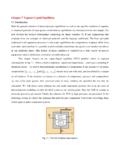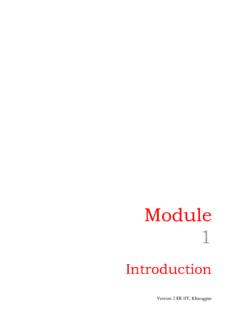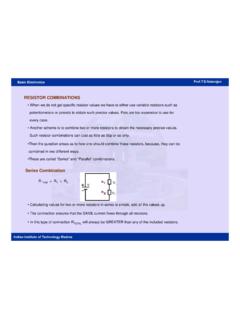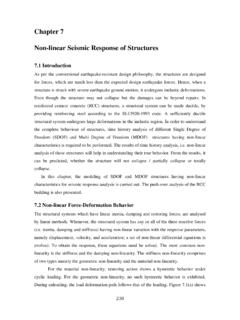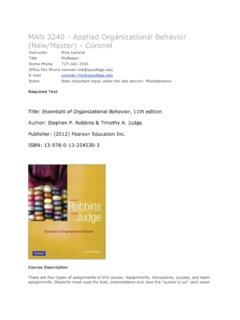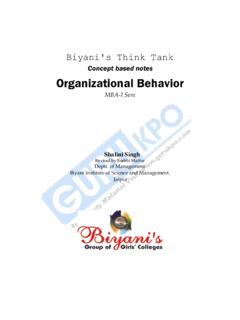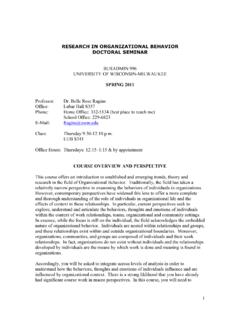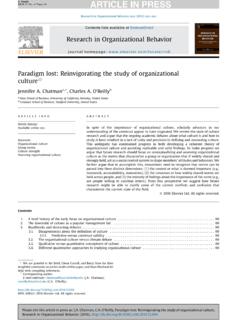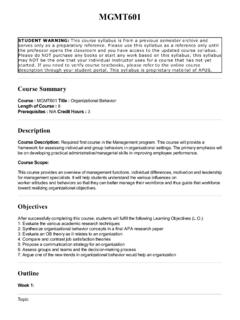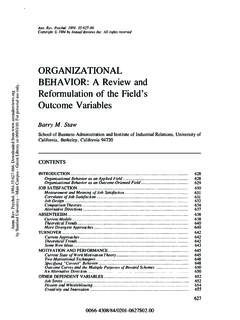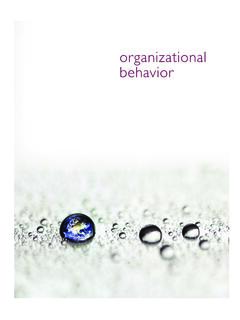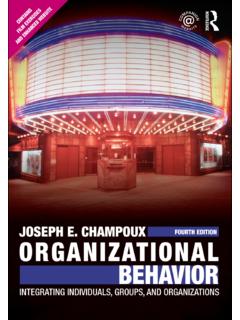Transcription of CHAPTER ONE- Understanding Organizational Behaviour …
1 MODULE ONE. FUNDAMENTALS OF Organizational Behaviour (Four hours). CHAPTER ONE- Understanding Organizational Behaviour (one hour). CHAPTER TWO- Effectiveness in organizations (one hour). CHAPTER THREE- Social systems and Organizational culture (two hours). Reference: 1. Organizational Behaviour , Stephen , Timothi and Seema Sanghi, 12th ed, Prentice Hall India 2. Organizational Behaviour -Human Behaviour at work by John W Newstrom, 12th edition, McGrawHill 3. Organizational behavior and management by Ivancevich, Konopaske and Matteson - 7th edition, Tata McGrawHill 4. Organisational Behaviour by Steven L Mc Shane Mary Ann Von Glinow Radha R. Sharma Tata McGrawHill 5. Organizational behavior by Don Hellriegel; John W. Slocum; Richard W. Woodman-8th edition, Thomson South-Western Prepared By Dr Susmita Mukhopadhyay Assistant Professor, VGSOM, IIT Kharagpur CHAPTER One Understanding Organizational Behaviour Objectives Understanding the meaning of Organizational Behaviour Understanding the fundamental concepts connected with Organizational Behaviour Understanding the basic approaches of Organizational Behaviour Framing the study of Organizational Behaviour Understanding the goals of Organizational Behaviour .
2 Knowing the importance of Organizational Behaviour for the managers. INTRODUCTION. Mintzberg (1973) identified ten separate roles in managerial work, each role defined as an organised collection of behaviours belonging to an identifiable function or position. He separated these roles into three subcategories: interpersonal contact, information processing and decision making. Interpersonal contact FIGUREHEAD: the manager performs ceremonial and symbolic duties as head of the organisation;. LEADER: fosters a proper work atmosphere and motivates and develops subordinates;. LIASION: develops and maintains a network of external contacts to gather information;. Information processing MONITOR: gathers internal and external information relevant to the organisation;. DISSEMINATOR: transmits factual and value based information to subordinates;. SPOKESPERSON: communicates to the outside world on performance and policies. Decision making ENTREPRENEUR: designs and initiates change in the organisation.
3 DISTURBANCE HANDLER: deals with unexpected events and operational breakdowns;. RESOURCE ALLOCATOR: controls and authorises the use of organisational resources;. NEGOTIATOR: participates in negotiation activities with other organisations and individuals. Mintzberg next analysed individual manager's use and mix of the ten roles according to the six work related characteristics. He identified four clusters of independent variables: external, function related, individual and situational. He concluded that eight role combinations were 'natural' configurations of the job: contact manager -- figurehead and liaison political manager -- spokesperson and negotiator entrepreneur -- entrepreneur and negotiator insider -- resource allocator real-time manager -- disturbance handler team manager -- leader expert manager -- monitor and spokesperson new manager -- liaison and monitor (Taken from ). For performing these roles , skills required by the managers are: Technical Skills-The ability to apply specialized knowledge or expertise Human Skills-The ability to work with, understand, and motivate other people, both individually and in groups Conceptual Skills-The mental ability to analyze and diagnose complex situations The managers will be effective in these roles when he possesses the required skills, understands the organization and its employees properly.
4 However some key facts about life at work: Organizations are complex systems Human behavior in organizations is sometimes unpredictable Human behavior in an organization can be partially understood There is no perfect solution to Organizational problems. In an Organization, employees do not have the luxury of not working with or relating to other people . Therefore, to be effective in an organization, it is imperative that an employee learns about human behavior , explore how to improve his/her interpersonal skills and begin to manage his/her relationships with others at work. These are the areas where knowledge of Organizational Behaviour can make a significant contribution to the employee's effectiveness. Organizational behavior is a scientific discipline in which large number of research studies and conceptual developments are constantly adding to its knowledge base. It is also an applied science, in that information about effective practices in one organization is being extended to many others.
5 Meaning of Organizational Behaviour Organizational behavior is the systematic study of human behavior , attitudes and performance within an Organizational setting; drawing on theory methods and principles from such disciplines as psychology, sociology and cultural anthropology to learn about individual perceptions, values, learning capacities and actions while working in groups and careful application of knowledge about how people- as individuals and as groups- act within the total organization; analyzing the external environment's effect on the organization and its human resources, missions, objectives and strategies. The above definition of OB highlights on its several aspects like: a. Way of thinking requires clearly identifying the level of analysis (individual, group, Organizational ). b. Multi-disciplinary draws principles, theories, and models from psychology, sociology and cultural anthropology. c. Humanistic orientation assumes that individual feelings, attitudes, perceptions, goals, etc.
6 , are important to the organization. d. Performance-oriented focusing on whether and why individual/group/organization performance is high, moderate, or low. e. External environment substantially impacts Organizational behavior . f. Scientific method plays a critical role in OB research. g. Applications oriented concerned with providing useful/applicable answers to management problems. Contribution of Behavioural Science The disciplines of psychology, social psychology, sociology and cultural anthropology contribute heavily to the subject matter of OB. The exhibit (Exhibit 1-3 from Organizational Behaviour , Stephen , Timothi and Seema Sanghi, 12th ed, PHI, pp 13)represents the various contributions of Behavioural science in Understanding the three unit of analysis of OB. Fundamental concepts connected with Organizational behavior Fundamental concepts are basic principles that form a strong foundation for OB. OB has a set of fundamental concepts revolving around the nature of people and organizations.
7 The Nature of People The six basic concepts relevant to the nature of people are: Law of individual differences-Each person is substantially different from all others in terms of their personalities, needs, demographic factors and past experiences and/or because they are placed in different physical settings, time periods or social surroundings. This diversity needs to be recognized and viewed as a valuable asset to organizations. Perception- Perception is the unique way in which each person sees, organizes and interprets things based on their background of individual differences. Each person reacts not to an objective world, but to a world judged in terms of his/her own beliefs, values and expectations. Sometimes it may lead to selective perception in which people tend to pay attention to only those things that are consistent with or reinforce their own expectations. Selective perceptions may lead to misinterpretation of single events at work or create a barrier in the search for new experience.
8 Managers need to recognize the perceptual differences among the employees and manage them accordingly. A whole person- People function as total human beings. People are physical, mental, social and spiritual beings and the organization actually employs the whole person rather than certain characteristics. There are spillover effects between the work life and life outside work and management's focus should be in developing not only a better employee but also a better person in terms of growth and fulfillment. If the whole person can be developed , then benefits will extend beyond the firm into the larger society in which each employee lives. Motivated Behaviour - Individual's behavior are guided by their needs and the consequences that results from their acts. In case of needs, people are motivated not by what others think they ought to have but by what they themselves want. Motivation of employees is essential to the operation of organizations and the biggest challenge faced by managers.
9 Desire for Involvement-Many employees actively seek opportunities at work to become involved in relevant decisions, thereby contributing their talents and ideas to the organization's success. Consequently, organizations need to provide opportunities to the employees for meaningful involvement. Value of the Person- People want to be treated with care, dignity and respect and increasingly they are demanding such treatment from their employers. They want to be valued for their skills and abilities and to be provided with opportunities to develop themselves. The Nature of Organizations The three key concepts related to the nature of organizations are: Social systems- Sociology tells that organizations are social systems. Just have people have psychological needs they also have social roles and status. Their behavior is influenced by their group as well as their by their individual drives. Two types of social systems exist side by side in the organization- the formal (official ) social system and the informal social system- each influencing and getting influenced by the other.
10 Mutual Interest-There is a mutuality of interest between the organization and its employees. Organization needs employees to reach its objectives and people need organizations to help them reach individual objectives. Mutual interest provides a superordinate goal one that can be attained only through the integrated efforts of individuals and their employees. Ethics- Ethics is the use of moral principles and values to affect the behavior of individuals and organizations with regard to choices between what is right and wrong. In order to ensure a higher standard of ethical performance by managers and employees companies have established codes of ethics, publicized statements of ethical values and set up internal procedures to handle misconduct. Since Organizational behavior involves people, ethical philosophy is involved in one way or another in each action they take. When organization's goals and actions are ethical, individual, Organizational and social objectives are more likely to be met.
